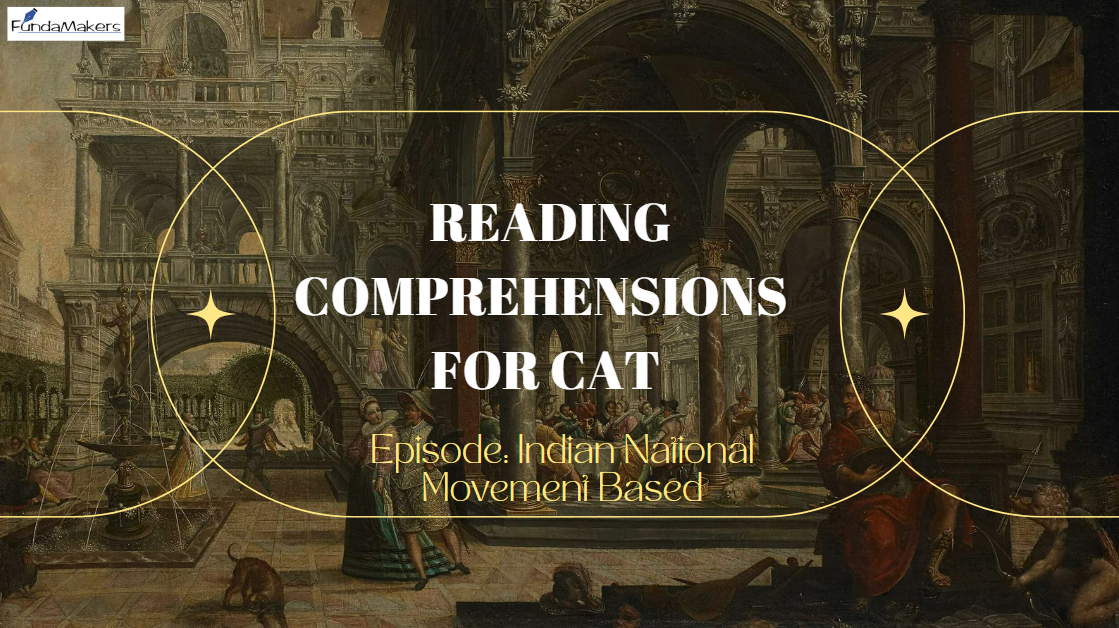Reading about the Indian National Movement is crucial for CAT VARC (Verbal Ability and Reading Comprehension) preparation as it enriches one’s understanding of a pivotal historical period, enhancing comprehension skills and contextual knowledge. This movement, marked by diverse ideologies, strategies, and significant figures, offers a rich tapestry of narratives and perspectives. Engaging with these texts not only aids in developing critical reading and analytical abilities but also equips aspirants with cultural and historical insights that are often reflected in CAT passages. Consequently, familiarity with the Indian National Movement can significantly boost one’s performance in comprehending complex passages and answering related questions effectively.
Passage 1.
The Indian National Congress (INC) was established in 1885 by Allan Octavian Hume, a retired Civil Service Officer, who recognized the growing political awareness among Indians and sought to channel it through a constitutional means to prevent any uprising against British rule. His initiative was backed by the Viceroy, Lord Dufferin, and a notable group of Indians. Womesh Chandra Banerjee from Calcutta became the first President of the Congress. The INC symbolized the desire of politically aware Indians to form a national body dedicated to their welfare. The leaders of the INC had strong faith in the British Government’s sense of justice, believing that presenting their grievances logically would lead to their resolution. Prominent liberal leaders included Firoz Shah Mehta, Gopal Krishna Gokhale, Dadabhai Naoroji, Ras Behari Bose, and Badruddin Tyabji. However, from 1885 to 1905, the Congress had a limited social base, primarily influencing urban educated Indians.
Questions:
- Who founded the Indian National Congress in 1885?
- a) Lord Dufferin
- b) Womesh Chandra Banerjee
- c) Allan Octavian Hume
- d) Gopal Krishna Gokhale
- Answer: c) Allan Octavian Hume
- What was the main reason behind Allan Octavian Hume’s initiative to form the INC?
- a) To start a popular agitation against British rule
- b) To channel the political consciousness of Indians constitutionally
- c) To oppose the Viceroy, Lord Dufferin
- d) To create a military uprising
- Answer: b) To channel the political consciousness of Indians constitutionally
- Who was elected as the first President of the Indian National Congress?
- a) Allan Octavian Hume
- b) Lord Dufferin
- c) Dadabhai Naoroji
- d) Womesh Chandra Banerjee
- Answer: d) Womesh Chandra Banerjee
- During the period from 1885 to 1905, what was the primary social base of the Indian National Congress?
- a) Rural farmers
- b) Urban educated Indians
- c) Industrial workers
- d) British officials
- Answer: b) Urban educated Indians
Passage 2.
The Congress initially presented its requests to the government as petitions and operated within legal boundaries, leading to the early Congress leaders being called ‘Moderates.’ For the first two decades, the Congress made moderate demands, including the establishment of representative legislatures, Indianization of services, reduction of military expenses, education and employment opportunities, conducting the ICS exam in India, lessening the burden on farmers, protecting civil rights, separating the judiciary from the executive, reforming tenancy laws, reducing land revenue and salt duties, promoting Indian industries and handicrafts, and introducing welfare programs.
Despite these efforts, significant changes in British policies and administration in India were not achieved. Initially, the British were supportive of the Congress, but their attitude shifted by 1887, and they did not meet the Moderates’ demands. The Congress’s notable achievement was the Indian Councils Act of 1892, which slightly expanded the legislature and allowed the ICS exam to be held in both London and India. Many leaders eventually lost faith in the constitutional methods. Although the Congress did not fully succeed, it fostered national awareness and a sense of unity among Indians, provided a platform for discussing national issues, and offered political training through government criticism. Their most significant contribution was laying the foundation for a strong national movement.
Questions:
- How did the Congress initially present its demands to the government?
- A) Through protests and strikes
- B) By submitting petitions
- C) Via violent confrontations
- D) Through international forums
- What was one of the moderate demands made by the Congress in its early years?
- A) Complete independence from British rule
- B) Establishment of representative legislatures
- C) Immediate expulsion of British officials
- D) Total abolition of military forces
- What was the significant achievement of the Congress with the Indian Councils Act of 1892?
- A) Complete legislative independence
- B) Introduction of welfare programs
- C) Slight expansion of the legislature and ICS exams in India
- D) Total removal of land revenue and salt duty
- What was the most significant contribution of the Congress, despite not achieving all its goals?
- A) Complete eradication of British policies
- B) Formation of a strong national movement
- C) Immediate changes in British administration
- D) Total independence for India
Passage 3.
By this time, Gandhiji was convinced that supporting the government would be futile. Encouraged by his earlier success in Bihar, and considering past events and the actions of the British government, he decided to initiate a nationwide satyagraha against the proposed Rowlatt Act in 1919. He warned that if the government did not meet his demands, he would start the non-cooperation movement. Why did Gandhiji oppose the Act? It was because the Act granted the government extensive powers to suppress political activities and allowed for the detention of political prisoners without trial for two years. Gandhiji advocated for non-violent civil disobedience against these unjust laws. When the government ignored his demands, he launched the non-cooperation movement in August 1920, urging people to not cooperate with the British authorities. At this time, the Khilafat movement led by Muslims and the non-cooperation movement led by Gandhi converged into a united front against the British government.
Gandhi outlined a detailed program which included: (1) Surrendering titles and honorary offices and resigning from nominated positions in local bodies; (2) Refusing to attend official and non-official functions; (3) Gradually withdrawing children from government-controlled schools and colleges; (4) Gradually boycotting British courts by lawyers and litigants; (5) Refusing military, clerical, and labor classes from enlisting for service in Mesopotamia; (6) Boycotting elections to legislative councils by candidates and voters; (7) Boycotting foreign goods and promoting national schools and colleges.
Questions
- Why did Gandhiji decide to launch a nationwide satyagraha against the Rowlatt Act?
- A) He wanted to support the British government.
- B) He was not successful in Bihar.
- C) The Act gave the government enormous powers to repress political activities and allowed detention without trial.
- D) The British government requested it.
- What was one of the key actions in Gandhiji’s non-cooperation movement?
- A) Attending official and non-official functions.
- B) Enlisting for service in Mesopotamia.
- C) Boycotting foreign goods.
- D) Supporting British courts.
- Which movements merged into a common confrontation against the British government in 1920?
- A) Civil Disobedience and Quit India movements.
- B) Khilafat movement and Non-cooperation movement.
- C) Swadeshi movement and Salt Satyagraha.
- D) Home Rule movement and Simon Commission.
- What did Gandhiji suggest regarding children’s education in his program?
- A) Enrolling children in British-controlled schools.
- B) Gradually withdrawing children from officially controlled schools and colleges.
- C) Encouraging children to attend official functions.
- D) Promoting foreign education.
Test your Caliber with us!
FundaMakers provide a series of RCs, and previous year questions based on RCs on our site. Tap on ” CAT Question Bank” and visit our Question bank section perfectly tailored for CAT aspirants.
Visit the link below to practice reading comprehensions based on Science & Technology:



